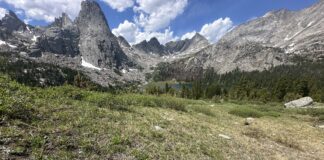
By Jerd Smith
As warm spring winds whip the Eastern Plains, sapping soils of moisture, and the state’s reservoirs sit at below-average levels, water managers got more bad news Tuesday: this two-year drought cycle could continue through the summer and into the fall leading the state into its third year of below-average snowpack and streamflows and high wildfire danger.
Looking ahead the weather pattern known as La Niña, which has created the intense drought of the past two years, is likely to continue, according to Peter Goble, a climate specialist with Colorado State University’s Colorado Climate Center.
“La Niña is not letting go,” Goble said Tuesday at a meeting of the state’s Water Availability Task Force, a group charged with monitoring the state’s water supplies. “It may stick around for a third year and this will reduce our chances of any meaningful drought recovery this spring and summer.”
In Colorado, and other Western states, mountain snow levels are closely watched because when they melt in late spring, they supply the majority of water for cities and farms.
In January, holiday snows boosted the state’s snowpack to 119% of average, according to the Natural Resources Conservation Service (NRCS). But spring snows have not provided as much relief as hoped.
Now, statewide snowpack is at 91% of average, according to the NRCS, an improvement over last year’s 79% of average mark at this time. But ultra-windy conditions and warm temperatures continue to rob the soils statewide of critical moisture, meaning a significant amount of the water from melting snow will be absorbed before it reaches streams.
Statewide snowpack at 91% of average
At the same time the state’s stored water supplies are at just 76% of normal, according to Karl Wetlaufer, a hydrologist and assistant snow survey supervisor with the NRCS.
“We’re seeing some of the lowest storage levels in more than 30 years,” Wetlaufer said.
Blue Mesa Reservoir is Colorado’s largest reservoir, able to store some 800,000 acre-feet of water. But due to the drought, and an emergency release of 36,000 acre-feet last summer to aid Lake Powell, Blue Mesa is just over 40% full.
More releases to Lake Powell from the reservoir, a recreational hot spot, may be necessary this summer. And because runoff isn’t expected to be that high, Blue Mesa isn’t expected to recover much, if at all this year, officials said.
“Blue Mesa is not expected to fill, and by the end of this year it will be right back to where it is now … it’s not looking good for this area,” said Beverly Richards, a water resources specialist with the Upper Gunnison River Water Conservancy District, which helps shape policy and management strategies for the river.
On the Front Range, some cities, such as Thornton, expect their reservoirs to fill. The South Platte Basin is near normal for its snowpack and streamflow forecasts are healthier than others across the state.
But Swithin Dick, water resources manager for Centennial Water and Sanitation District in Highlands Ranch, said the outlook is worrisome.
“My gut meter is moving from cautious to concerned,” Dick said.
Denver Water, Colorado’s largest city water supplier, derives its supplies from the Upper Colorado River Basin on the West Slope, as well as the South Platte River. Its storage system is at 79% full, while snowpack in its mountain watersheds is measuring 79% to 80% full.
Some relief from the dry, windy weather could come in May if forecasts prove to be off track, Goble said.
“You want some million dollar rains on the Eastern Plains,“ Goble said. “But the deck is stacked against us.”
Jerd Smith is editor of Fresh Water News. She can be reached at 720-398-6474, via email at jerd@wateredco.org or @jerd_smith.
Fresh Water News is an independent, nonpartisan news initiative of Water Education Colorado. WEco is funded by multiple donors. Our editorial policy and donor list can be viewed at wateredco.org
The Water Desk’s mission is to increase the volume, depth and power of journalism connected to Western water issues. We’re an initiative of the Center for Environmental Journalism at the University of Colorado Boulder. The Water Desk launched in April 2019 with support from the Walton Family Foundation. We maintain a strict editorial firewall between our funders and our journalism.





